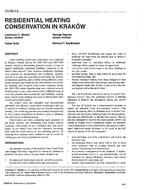
CH-95-02-2– Residential Heating Conservation in Krakow
A four-building conservation experiment was conducted in Krakow, Poland, during the 1992-1993 and 1993-1994 winters, aimed at determining potential savings of heat in typical multifamily residential buildings connected to the district heat network. Four identical multifamily buildings were selected for measurement and retrofitting. Together with the US team, the local district heat utility, the Krakow development authority, and a Polish energy-efficiency foundation designed and conducted the 264-residence test of utility, building, and occupant conservation strategies during the 1992-1993 winter. Baseline data were collected on each building prior to any conservation work. A different scope of work was planned and executed for each building, ranging from controls at the building level only, to thermostatic valve control and weatherisation. The project team has identified and demonstrated affordable and effective conservation technologies that can be applied to Krakow’s existing concrete-element residential housing. The results suggest that conservation strategies will be key to many alternatives in Krakow’s plan to eliminate low-emission air pollution sources. Conservation can allow more customers to be connected to the utility network and eliminate local boilers without requiring construction of new combined heat and power plants. It can reduce heat costs for customers converting from solid-fuel heat sources to less polluting sources. By reducing heat demand, more customers can be served by existing gas and electric distribution systems.
KEYWORDS: year 1995, domestic, heating, district heating, Poland, experiment, winter, energy conservation, energy consumption, flats, measuring, modernising, heat load, controls, thermal insulation, caulking, weather strips, foils
Citation: Symposium, ASHRAE Trans. 1995, Vol.101, Part 1, Paper number CH-95-1-1, 525-527
Product Details
- Published:
- 1995
- File Size:
- 1 file , 1 MB
- Product Code(s):
- D-16762


